|
| |
|
Acquiring Quality Antique Clocks
by Bob Brooke
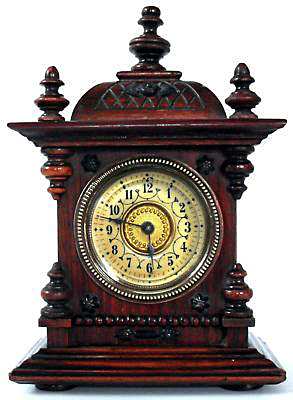 Not
every old clock is worth collecting. In fact, collecting clocks can be a
challenge because of the amount of space they take up. So people who do
collect them are very particular. Not
every old clock is worth collecting. In fact, collecting clocks can be a
challenge because of the amount of space they take up. So people who do
collect them are very particular.
In selling real estate, location is prime. But in antique clock
collecting, condition is all important. To be worth anything, an antique
clock needs to be in working order—in other words, it needs to tell time
almost as good as it did when it was first made.
Prior to the 19th century, master clockmakers produced fewer than two
dozen clocks per year. These were tall-case clocks. referred to today as
grandfather clocks. The term grandfather clock wasn’t used until after
1876. when a song American composer Henry Clay wrote, called “My
Grandfather's Clock,” became popular. While these early clocks
demonstrated the finest quality of workmanship, the cost of $50 or more
excluded anyone but the very rich from owning one.
The Willard
Brothers
Toward the end of the 18th century, two brothers, Simon and Aaron
Willard. made an abbreviated version of the tall-case clock. The
Massachusetts shelf clock resembled the top half of a grandfather clock.
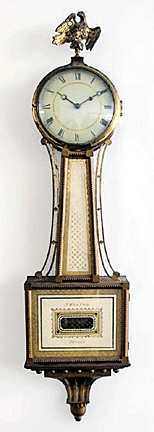 In
1802, Simon patented his improved “Timepiece," a wall clock shaped like
a banjo. This style would be copied many times. Years later, the
Waterbury Clock Company manufactured a number of banjo clocks and used
the name "Willard." In
1802, Simon patented his improved “Timepiece," a wall clock shaped like
a banjo. This style would be copied many times. Years later, the
Waterbury Clock Company manufactured a number of banjo clocks and used
the name "Willard."
While the Willards introduced new lock styles, it was Gideon Roberts, a
Revolutionary War veteran from Bristol, Connecticut, who began to make
clockc more affordable. Roberts replaced the brass movements used up to
that time with less expensive wooden ones and also used painted paper
dials. Imitating the German styling known as #wag-on-the-wall,” Roberts
also made clocks without case. The exposed works could be encased for an
additional fee. Using these methods, Roberts was able to produce 10 or
more clocks at a time.
While these production methods were innovative, it was Eli Terry who
historians generally credit with bringing mass-production to America. In
1797, Terry received the first American clock-related patent. In 1807,
he signed a contract to make 4,000 clock movements within three years.
Legend has it that Terry spent the first two years designing and
constructing the machinery, which would allow him to fulfill his
obligation. In 1810, with the help of apprentices Seth Thomas and Silas
Hoadley, Terry's “pillar-and-scroll” shelf clock became the first
inexpensive, factory-produced clock available to the American public.
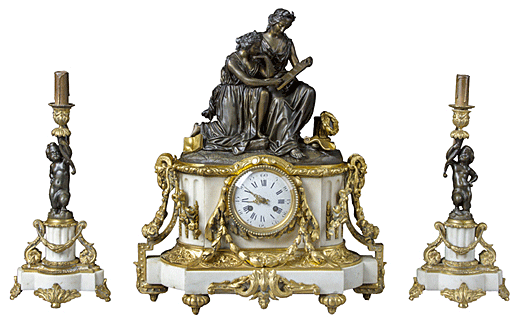
Thomas and Hoadley purchased Terry's factory that same year and worked
together until 1813. Eventually, Thomas became one of America's
best-known clockmakers.
Important
American Clockmakers
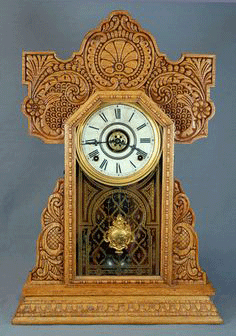 The
American clock industry continued to thrive through the first half of
the 19th century. An 1850 census listed clockmaker as the occupation of
582 Connecticut residents. Well-known makers included the Ansonia Clock
Company, in business from . 1850 to 1929, The Waterbury Clock Company,
operating from 1850 to 1944, The New Haven Clock Company, producing
clocks from 1853 to 1960, E.N. Welch Manufacturing Company, in business
from 1831 to 1903, the William L. Gilbert Clock Company, making clocks
from 1828 to 1964, and The E. Ingraham Company, operating from 1828 to
1967. The
American clock industry continued to thrive through the first half of
the 19th century. An 1850 census listed clockmaker as the occupation of
582 Connecticut residents. Well-known makers included the Ansonia Clock
Company, in business from . 1850 to 1929, The Waterbury Clock Company,
operating from 1850 to 1944, The New Haven Clock Company, producing
clocks from 1853 to 1960, E.N. Welch Manufacturing Company, in business
from 1831 to 1903, the William L. Gilbert Clock Company, making clocks
from 1828 to 1964, and The E. Ingraham Company, operating from 1828 to
1967.
By 1850, technology changed most movements from weight to spring-driven,
replacing brass coiled springs with cheaper steel springs. Among the
most popular clocks were the schoolhouse clock, the pressed oak
"gingerbread" kitchen clock, the steeple clock and the OG clock, which
featured a double continuous S-shaped molding.
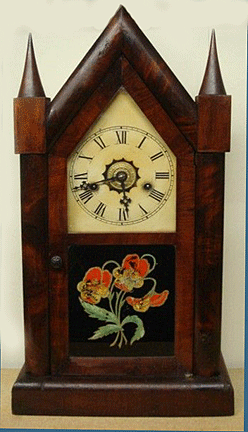 Researching
an antique clock’s origins can be challenging. Those made in the 18th
and at least the first half of the 19th century bore no labels. Some
clockmakers did sign their works, especially those that made tall case
clocks. Generally, they signed them somewhere on the dial. Many of those
that did have labels in the latter part of the 1800s, lost them over
time. Researching
an antique clock’s origins can be challenging. Those made in the 18th
and at least the first half of the 19th century bore no labels. Some
clockmakers did sign their works, especially those that made tall case
clocks. Generally, they signed them somewhere on the dial. Many of those
that did have labels in the latter part of the 1800s, lost them over
time.
The key to acquiring museum quality clocks is learning how to research,
properly identify and evaluate antique clocks. The primary factors are
condition, originality, rarity and provenance. Unfortunately, thousands
of clocks on eBay aren’t properly identified. Beware of vague
descriptions. Whether a collector buys clocks online, at auction, or at
a shop, novices should consider hiring an expert as their broker,
especially when paying serious money.
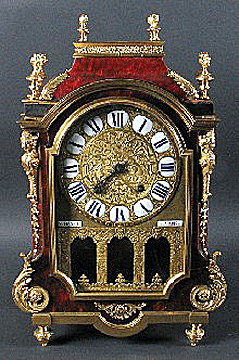 An
antique clock isn’t always as good as it appears. While a clock may look
great from the outside, the condition of its works is what counts. Over
time, abuse and bad repairs can add up, rendering what could have been a
great find nearly worthless. Rarity, provenance, originality, quality of
manufacture, and quality of restoration all affect value. An
antique clock isn’t always as good as it appears. While a clock may look
great from the outside, the condition of its works is what counts. Over
time, abuse and bad repairs can add up, rendering what could have been a
great find nearly worthless. Rarity, provenance, originality, quality of
manufacture, and quality of restoration all affect value.
The sad thing is that many antique clocks cannot be repaired. Even the
best horologist can’t work miracles on many old clockworks. The reason
is that most cannot obtain the parts needed to do the repairs. And the
few younger clockmakers just don’t have the skills necessary to make the
parts themselves.
Unlike a piece of antique furniture that has been restored, an antique
clock that isn’t running isn’t worth collecting.
< Back to Collecting Archives
Next Article >
|
|

|
|
FOLLOW MY WEEKLY BLOG
Antiques Q&A
JOIN MY COLLECTION
Antiques and More
on Facebook
LIKE MY FACEBOOK PAGE
The Antiques
Almanac on Facebook |
|
No antiques or collectibles
are sold on this site.
|
|
How to Recognize and
Refinish Antiques for Pleasure and Profit
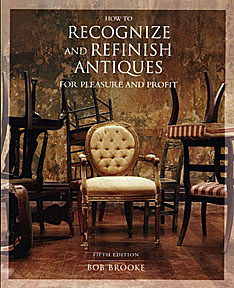
Have
you ever bought an antique or collectible that was less than perfect and
needed some TLC? Bob's new book offers tips and step-by- step
instructions for simple maintenance and restoration of common antiques.
Read an
Excerpt
|
|

|
|
|
|
|
